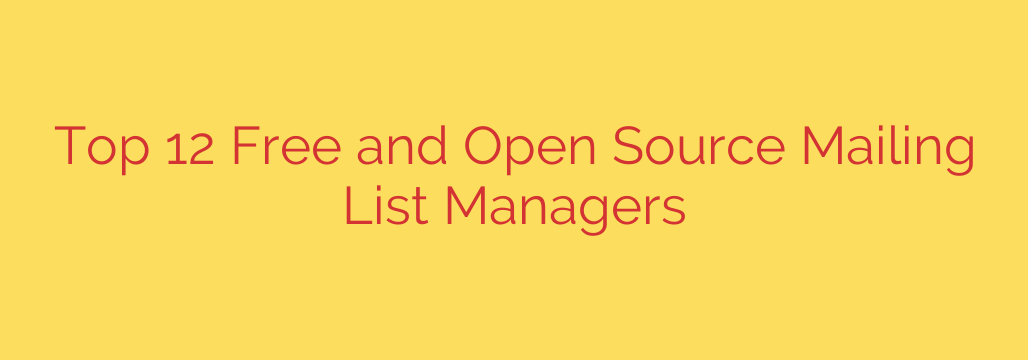
Unlock Your Email Strategy: The Best Free & Open Source Mailing List Software
Email remains one of the most powerful and direct ways to connect with your audience, whether you’re running a community, promoting a business, or sending out a family newsletter. While commercial email marketing platforms offer convenience, they often come with high costs, subscriber limits, and concerns about data privacy.
Fortunately, there’s a powerful alternative: free and open-source mailing list management software. By hosting your own solution, you gain unparalleled control over your data, features, and budget.
Opting for a self-hosted mailing list manager provides several key advantages over paid subscription services. These benefits include:
- Complete Data Ownership: Your subscriber lists and campaign data are stored on your own server. You control who has access, ensuring maximum privacy and compliance with regulations like GDPR.
- No Subscriber-Based Fees: The primary cost is your server hosting, not how many subscribers you have. This makes scaling your audience incredibly cost-effective.
- Limitless Customization: With access to the source code, you can tweak, modify, and integrate the software to perfectly fit your needs. You are not locked into a vendor’s feature set.
- Enhanced Transparency and Security: Open-source code can be audited by a global community of developers, leading to robust and transparent security practices. You control when and how updates are applied.
Top Open Source Mailing List Managers to Consider
Navigating the world of open-source software can be daunting. To help you get started, here are some of the most respected and powerful mailing list managers available today.
Listmonk: The Modern, High-Performance Choice
Listmonk is a newer player that has quickly gained popularity for its simplicity and performance. Written in the Go programming language, it’s a lightweight, self-contained application that is easy to install and run.
- Key Features: Clean, modern user interface; high-performance email sending; powerful templating language; RESTful API for easy integration.
- Best for: Users who want a fast, modern, and straightforward newsletter and mailing list solution without a lot of bloat.
phpList: The Battle-Tested Industry Standard
For decades, phpList has been one of the most widely used open-source solutions for sending newsletters, marketing campaigns, and announcements. Its robust feature set and massive community make it a reliable choice for organizations of any size.
- Key Features: Advanced subscriber management; bounce and complaint handling; detailed statistics and analytics; extensive plugin library.
- Best for: Anyone looking for a feature-rich, highly reliable system capable of handling millions of messages. It’s a true workhorse.
Mailman: The Gold Standard for Discussion Lists
GNU Mailman is less of a marketing tool and more of a powerful manager for email discussions and community lists. It’s the software that powers countless mailing lists for open-source projects, academic institutions, and special interest groups.
- Key Features: Robust moderation and administration tools; message archiving with a searchable web interface; automatic bounce detection; flexible configuration options.
- Best for: Creating and managing community discussion forums, technical support lists, or internal company announcement groups.
Dada Mail: User-Friendly and Feature-Rich
Written in Perl, Dada Mail has a long history and is known for its focus on user-friendly installation and management. It strikes a great balance between powerful features and ease of use, making it accessible even for those with less technical expertise.
- Key Features: Web-based installation wizard; supports complex list segmentation; powerful subscription and unsubscription controls; integrated message archive.
- Best for: Small businesses, non-profits, or individuals who want a powerful mailing list manager without a steep learning curve.
How to Choose the Right Software For You
Selecting the best open-source tool depends entirely on your specific needs. Before you decide, ask yourself these questions:
- What is your primary goal? Are you sending marketing newsletters, running a community discussion list, or sending transactional emails?
- What is your technical comfort level? Some tools require more command-line knowledge than others. Check the installation requirements carefully.
- What is your server environment? Ensure the software is compatible with your web server (e.g., PHP, Perl, Go).
- How large is your list? For very large lists, performance is key. Look for solutions like Listmonk or a properly configured phpList.
A Critical Note on Security and Email Deliverability
Running your own mailing list software comes with responsibility. Here are essential tips for success:
- Keep Your Software Updated: Security is paramount. Always apply the latest patches and updates to protect your server and your subscribers’ data from vulnerabilities.
- Master Email Authentication: To ensure your emails land in the inbox and not the spam folder, you must properly configure your domain’s DNS records. Setting up SPF, DKIM, and DMARC is not optional—it is essential for deliverability.
- Use a Professional SMTP Relay: While your software will manage the lists, it’s often best to use a dedicated service for sending the emails. Services like Amazon SES, SendGrid, or Postmark are designed for high-volume sending and have strong relationships with ISPs, which dramatically improves your deliverability rates.
By taking control with a free and open-source mailing list manager, you can build a more powerful, private, and cost-effective email strategy that grows with you.
Source: https://www.linuxlinks.com/mailinglistmanagers/








